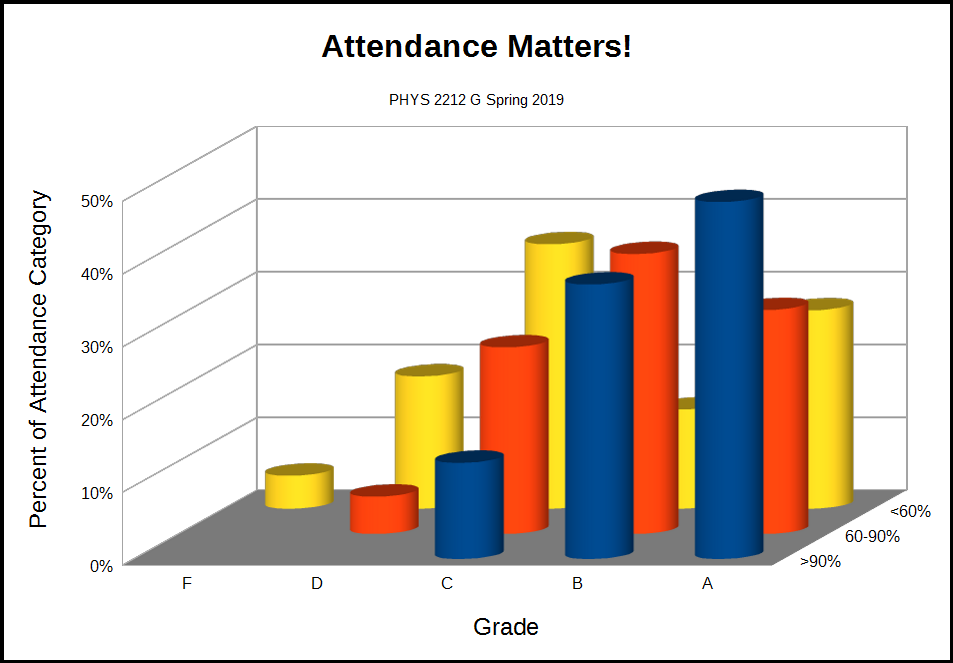Welcome to PHYS 2212 G!
Check this location regularly for important information.
You are responsible for everything posted here.
- May 03
- Grades & Attendance
You may be interested in the distribution of course grades by class attendance (based on sign-in sheets) in PHYS 2212 G. The graph is showing that, for example, 49% of the students with "Good" attendance (greater than or equal to 90%) earned a A. The class GPA for students with Good attendance was 3.4. That for those with Fair attendance (60 to 90%) was 3.0, while that for those with Poor attendance (less than 60%) was 2.4. From another perspective, students with Good attendance were 46% of the class, yet they earned 59% of the A's. Student with Poor attendance were 19% of the class, but they earned 67% of the D's and 100% of the F's. Note that no student with Good attendance earned a D or an F! -

- If you compare the above graph to the results for Fall 2008 through Summer 2010 posted at the beginning of the semester, you'll see that the trends are always the same! I'd like to thank those students who made the effort to attend class and participate.
- May 03
- Course Grades
Course Grades are available available in the Canvas PostEm tool. If you think your grade is erroneous, please contact Dr. Murray. On the other hand, if you just wish your grade were different, please do not contact Dr. Murray! Grades are determined by the same standards for all students, and all possible consideration has already been given. - May 03
-
Final Exam Grades
Final Exam grades are available available in the Canvas Gradebook. An adjustment was made to compensate for a difference in difficulty between the Regular and Conflict exams, so scores may exceed 100%. Exam forms will not be released through Gradescope, although if you stop by his office, Dr. Murray will be happy to go over your exam with you. Contact Dr. Murray to schedule an appointment, or if you have any questions. - Apr 30
-
Lab Averages
Final Lab Averages are available in the Canvas lecture Gradebook. Each student's poorest lab grade was dropped. If your lab grade seems surprisingly low, don't forget the penalty for excessive absences. Contact Dr. Murray if you think your posted Lab Average is in error. - Apr 25
-
Recitation averages
Final Recitation Averages are available in the Canvas lecture gradebook. Each student's poorest recitation grade was dropped. Contact Dr. Murray if you think your posted Recitation Average is in error. - Apr 23
-
"Other" Points
"Other" Points have been calculated and are available in the Canvas gradebook. Recall that "Other" consists of these items, each of which is available in the Canvas PostEm tool:
If you wish to verify the calculation,Weight in Course Regular Homework 5+2% Practice Homework 4% Class Participation 4% Reading Questions 2% Public Lectures 1% - If your Regular Homework average exceeds 100% due to working it on a daily, rather than weekly, basis, temporarily treat it as 100%
- Multiply each component of the "other" grade by the weight above (with Regular Homework at 5%)
- If the sum of those weighted components exceeds 10 points, discard the excess
- If your Regular Homework average was 100% or less, this weighted sum should match the value in the Canvas Gradebook
- If your Regular Homework average was more than 100%, divide the excess by 0.2 and add it to the weighted sum. For example, if your Regular homework average was 110%, the amount exceeding 100% is 10%, or 0.1. Then 0.1/0.2 = 0.5, so the value in the Canvas Gradebook should be 0.5 points greater than the weighted sum.
- Apr 23
-
Extra Credit
Extra credit for the Diagnostic and Concept Tests has been calculated and is available in the Canvas gradebook as "XC Points". If you wish to verify the calculation, divide the sum of your points by 128 (each had 32 points, for a maximum total of 64, so dividing by 128 yields a value betwen zero and 0.5). Then add 0.25 for each one you earned a score greater than zero on. The resulting total, between zero and one point, will be added to your course average.
